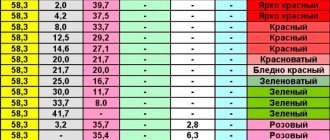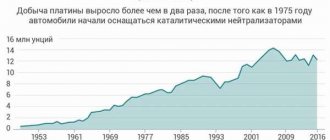PNG images with transparent background
Home » JEWELS AND STONES » Gold Gold
is an element of group 11 (according to the outdated classification - a secondary subgroup of the first group), the sixth period of D. I. Mendeleev’s periodic table of chemical elements, with atomic number 79. Denoted by the symbol Au. The simple substance gold is a noble metal of yellow color.
Pure gold is a soft yellow metal. The reddish hue of some gold products, such as coins, is given by impurities of other metals, in particular copper. In thin films, gold shows through green. Gold has high thermal conductivity and low electrical resistance.
Gold is a very heavy metal: the density of pure gold is 19.32 g/cm³ (a ball of pure gold with a diameter of 46.237 mm has a mass of 1 kg). Among metals, it ranks seventh in density after osmium, iridium, platinum, rhenium, neptunium and plutonium. Tungsten has a density comparable to gold (19.25). The high density of gold makes it easier to extract, which is why even simple technological processes - for example, washing at sluices - can provide a high degree of gold recovery from the washed rock.
Gold is a very soft metal: hardness on the Mohs scale is ~2.5, on the Brinell scale 220-250 MPa (comparable to the hardness of a fingernail).
Gold is also highly ductile: it can be forged into sheets up to ~0.1 µm (100 nm) thick (gold leaf); With such a thickness, gold is translucent and in reflected light has a yellow color, in transmitted light it is colored bluish-greenish, complementary to yellow. Gold can be drawn into wire with a linear density of up to 2 mg/m.
Gold is one of the most inert metals, standing to the right of all other metals in the stress series. Under normal conditions, it does not interact with most acids and does not form oxides, therefore it is classified as a noble metal, in contrast to ordinary metals, which are destroyed by acids and alkalis. In the 14th century, the ability of aqua regia to dissolve gold was discovered, which refuted the idea that it is chemically inert.
In this clipart you can download PNG photos: Gold PNG photo, gold bars PNG, gold coins PNG
- Gold PNG
Gold Format: PNG image Resolution: 256×256 Size: 15 kb
- Gold PNG
Gold Format: PNG image Resolution: 2207×2149 Size: 2422 kb
- Gold coin PNG
Gold Format: PNG image Resolution: 404×404 Size: 287 kb
- Gold PNG
Gold Format: PNG image Resolution: 1446×1442 Size: 667 kb
- Gold coins PNG
Gold Format: PNG image Resolution: 600×401 Size: 235 kb
- Gold coins PNG
Gold Format: PNG image Resolution: 2152×2722 Size: 3099 kb
- Gold nugget PNG
Gold Format: PNG image Resolution: 200×200 Size: 70 kb
- Gold nugget PNG
Gold Format: PNG image Resolution: 200×200 Size: 69 kb
- Gold nugget PNG
Gold Format: PNG image Resolution: 220×176 Size: 75 kb
- Gold coins PNG
Gold Format: PNG image Resolution: 479×285 Size: 269 kb
- Gold bullion PNG
Gold Format: PNG image Resolution: 650×666 Size: 93 kb
- Gold bullion PNG
Gold Format: PNG image Resolution: 200×200 Size: 31 kb
- Gold PNG
Gold Format: PNG image Resolution: 978×300 Size: 458 kb
- Gold PNG
Gold Format: PNG image Resolution: 384×235 Size: 133 kb
- Gold bars PNG
Gold Format: PNG image Resolution: 431×307 Size: 186 kb
- Gold bars PNG
Gold Format: PNG image Resolution: 2179×1387 Size: 2326 kb
- Gold PNG
Gold Format: PNG image Resolution: 600×595 Size: 219 kb
- Gold PNG
Gold Format: PNG image Resolution: 6148×2909 Size: 397 kb
- Gold PNG
Gold Format: PNG image Resolution: 6297×2077 Size: 454 kb
- Gold PNG
Gold Format: PNG image Resolution: 600×468 Size: 55 kb
- Gold coins PNG
Gold Format: PNG image Resolution: 3117×4000 Size: 1301 kb
- Gold coin PNG
Gold Format: PNG image Resolution: 887×885 Size: 400 kb
- Gold PNG
Gold Format: PNG image Resolution: 600×500 Size: 240 kb
- Gold bullion PNG
Gold Format: PNG image Resolution: 373×402 Size: 95 kb
- Gold PNG
Gold Format: PNG image Resolution: 2864×1490 Size: 550 kb
- Gold PNG
Gold Format: PNG image Resolution: 3456×1131 Size: 507 kb
- Gold PNG
Gold Format: PNG image Resolution: 4260×2948 Size: 1531 kb
- Gold PNG
Gold Format: PNG image Resolution: 354×352 Size: 84 kb
- Gold coins PNG
Gold Format: PNG image Resolution: 560×273 Size: 270 kb
- Gold coin PNG
Gold Format: PNG image Resolution: 591×583 Size: 566 kb
- Gold coin PNG
Gold Format: PNG image Resolution: 912×908 Size: 1365 kb
- Gold coin PNG
Gold Format: PNG image Resolution: 830×818 Size: 1123 kb
- Gold coins PNG
Gold Format: PNG image Resolution: 3153×1556 Size: 4464 kb
- Gold PNG
Gold Format: PNG image Resolution: 745×402 Size: 613 kb
- Gold PNG
Gold Format: PNG image Resolution: 559×321 Size: 209 kb
- Gold bullion PNG
Gold Format: PNG image Resolution: 1487×1408 Size: 1257 kb
- Gold PNG
Gold Format: PNG image Resolution: 888×587 Size: 625 kb
- Gold PNG
Gold Format: PNG image Resolution: 886×521 Size: 424 kb
- Gold PNG
Gold Format: PNG image Resolution: 857×514 Size: 395 kb
- Gold bullion PNG
Gold Format: PNG image Resolution: 1795×1029 Size: 1289 kb
- Gold PNG
Gold Format: PNG image Resolution: 848×1083 Size: 718 kb
- Gold bullion PNG
Gold Format: PNG image Resolution: 998×824 Size: 720 kb
- Gold PNG
Gold Format: PNG image Resolution: 1444×815 Size: 471 kb
- Gold bullion PNG
Gold Format: PNG image Resolution: 378×345 Size: 120 kb
- Gold nugget PNG
Gold Format: PNG image Resolution: 825×462 Size: 648 kb
- Gold nuggets PNG
Gold Format: PNG image Resolution: 864×621 Size: 842 kb
- Gold nugget PNG
Gold Format: PNG image Resolution: 1178×1099 Size: 1718 kb
- Gold nugget PNG
Gold Format: PNG image Resolution: 555×650 Size: 772 kb
- Gold nugget PNG
Gold Format: PNG image Resolution: 729×431 Size: 572 kb
- Gold nugget PNG
Gold Format: PNG image Resolution: 1676×1015 Size: 2233 kb
- Gold bars PNG
Gold Format: PNG image Resolution: 610×335 Size: 84 kb
- Gold PNG
Gold Format: PNG image Resolution: 997×440 Size: 946 kb
- Gold bars PNG
Gold Format: PNG image Resolution: 425×282 Size: 108 kb
- Gold PNG
Gold Format: PNG image Resolution: 3580×3402 Size: 1759 kb
- Gold PNG
Gold Format: PNG image Resolution: 640×320 Size: 50 kb
- Gold PNG
Gold Format: PNG image Resolution: 2152×2262 Size: 294 kb
- Gold PNG
Gold Format: PNG image Resolution: 800×486 Size: 75 kb
- Gold PNG
Gold Format: PNG image Resolution: 1135×723 Size: 903 kb
- Gold PNG
Gold Format: PNG image Resolution: 500×500 Size: 287 kb
- Gold PNG
Gold Format: PNG image Resolution: 800×800 Size: 76 kb
- Gold PNG
Gold Format: PNG image Resolution: 3000×2250 Size: 2695 kb
- Gold bullion PNG
Gold Format: PNG image Resolution: 960×480 Size: 253 kb
- Gold PNG
Gold Format: PNG image Resolution: 600×300 Size: 49 kb
- Gold PNG
Gold Format: PNG image Resolution: 425×282 Size: 108 kb
- Gold coins PNG
Gold Format: PNG image Resolution: 1057×964 Size: 1490 kb
- Gold PNG
Gold Format: PNG image Resolution: 600×300 Size: 49 kb
- Gold bullion PNG
Gold Format: PNG image Resolution: 256×256 Size: 24 kb
- Gold PNG
Gold Format: PNG image Resolution: 374×367 Size: 142 kb
- Gold PNG
Gold Format: PNG image Resolution: 600×444 Size: 351 kb
- Gold PNG
Gold Format: PNG image Resolution: 2957×2875 Size: 6474 kb
- Gold coins PNG
Gold Format: PNG image Resolution: 280×478 Size: 139 kb
- Gold PNG
Gold Format: PNG image Resolution: 4202×4196 Size: 1436 kb
- Gold PNG
Gold Format: PNG image Resolution: 2325×2400 Size: 594 kb
- Gold PNG
Gold Format: PNG image Resolution: 5326×2795 Size: 706 kb
- Gold PNG
Gold Format: PNG image Resolution: 600×600 Size: 291 kb
- Gold PNG
Gold Format: PNG image Resolution: 4486×1770 Size: 1788 kb
- Gold PNG
Gold Format: PNG image Resolution: 512×512 Size: 328 kb
- Gold bars PNG
Gold Format: PNG image Resolution: 292×300 Size: 94 kb
- Gold PNG
Gold Format: PNG image Resolution: 512×512 Size: 335 kb
- Gold PNG
Gold Format: PNG image Resolution: 1707×1707 Size: 1901 kb
- Gold PNG
Gold Format: PNG image Resolution: 2346×2250 Size: 286 kb
- Gold PNG
Gold Format: PNG image Resolution: 2329×2228 Size: 362 kb
- Gold PNG
Gold Format: PNG image Resolution: 336×336 Size: 30 kb
- Gold coin PNG
Gold Format: PNG image Resolution: 1890×1881 Size: 4813 kb
- Gold bullion PNG
Gold Format: PNG image Resolution: 500×500 Size: 112 kb
About the project | Odnoklassniki | Facebook | VKontakte | License | Use of cookies | Contacts
imgpng.ru Copyright © 2013 - 2021. PNG images with transparent background for design and web design
Where gold bars are born (30 photos)
While each of us can see any gold-bearing mine, not everyone will be able to get to the enrichment factory where “candy” is made from gold. Photo report by Igor Yagubkov from the gold bullion factory.
So where did we stop? Geologists found the very place where there was precious ore, then drilling and blasting began, movement appeared in the quarry, excavators took over the load and began loading large dump trucks around the clock. They, in turn, transported the ore to the crushing and screening complex and the ore preparation site. There the ore was crushed, stacked, the baton is taken over by the heap leaching section, where special solutions are fed to the so-called card (or heap) and the gold is separated from the ore, and the resulting solution, with a rich gold content, goes to the factory. And finally, it’s the turn of the enrichment factory, where they are already making “candy.” If any quarry can theoretically be seen by each of us, then not everyone can get to this holy place. Welcome, friends!
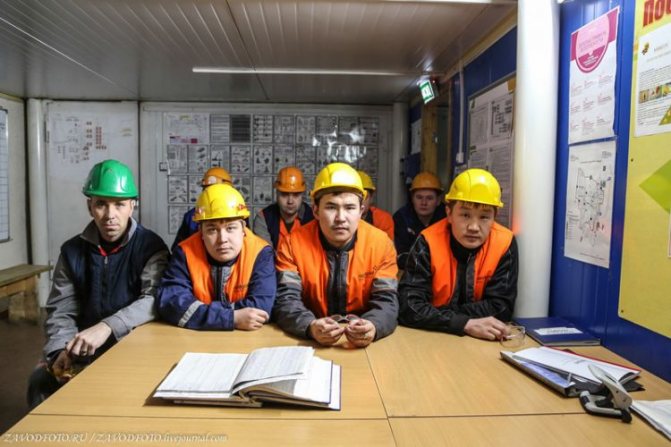
Hurray, the cordons with machine gunners and thorough inspections have passed, now we will choose the one who is to blame. Fortunately, everyone here in the deliberation room is a great specialist.
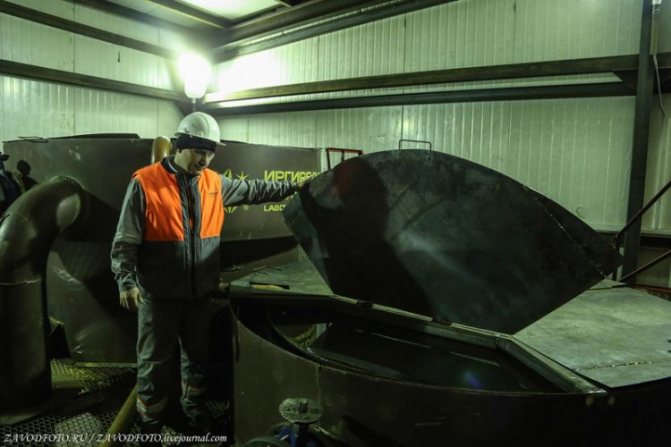
At the factory, the gold solution is first sorbed onto coal. Gold is desorbed from coal by electrolysis onto cathodes. The cathodes are washed away from cathode deposits and collected in a container for acid treatment. It is acidified to remove impurities, then washed and dried. After which it goes to the smelting department.
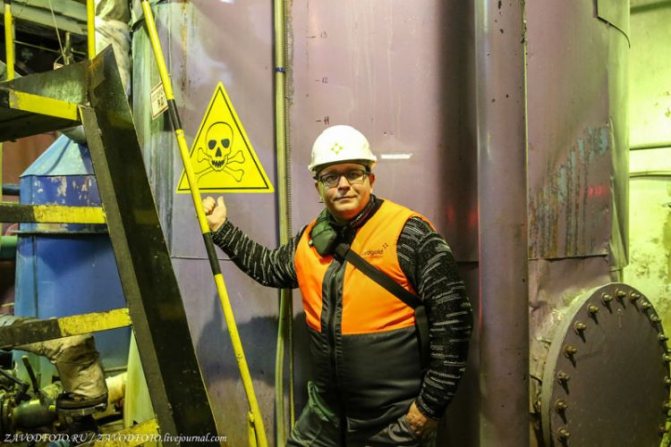
Strangers don't come here, otherwise it's a mess

Control over the supply of gold solution to sorption columns.
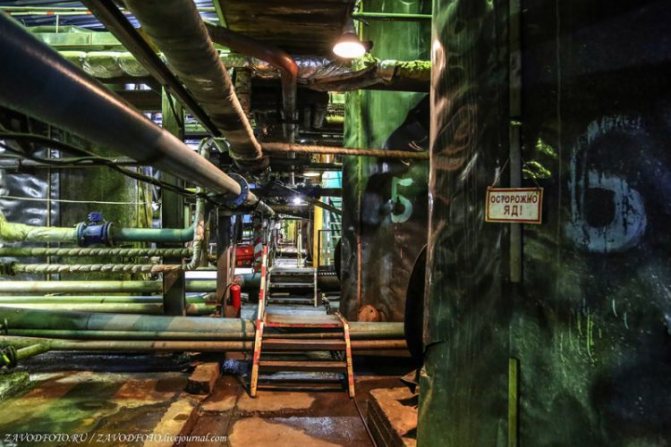
Mixing pipelines is something not everyone can figure out.
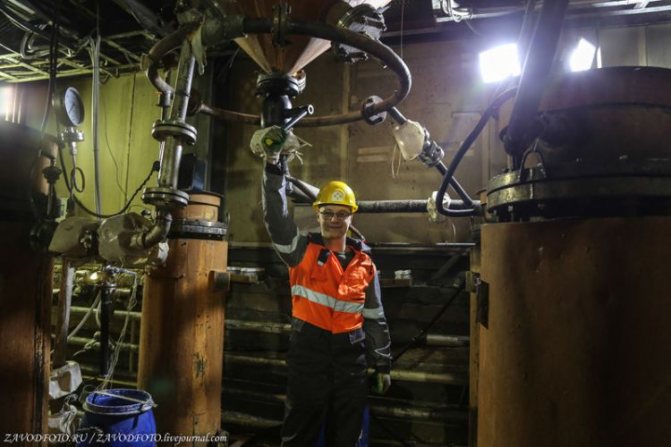
Control of coal discharge from the stripping column.
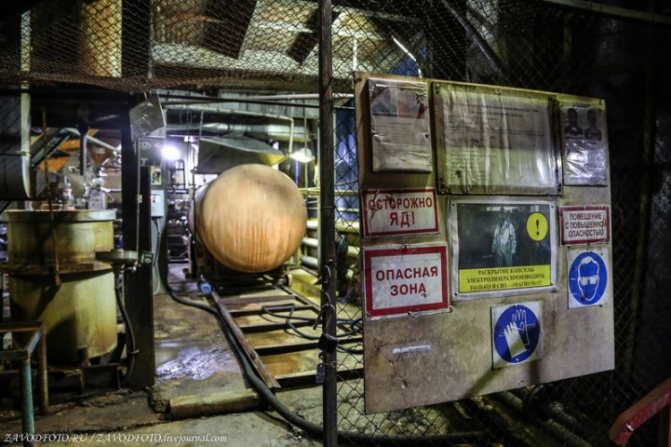
In the “Chinese desorption” department, gold is deposited onto cathodes; the process takes place under high pressure, so the room is a high-risk area where access is closed during operation.
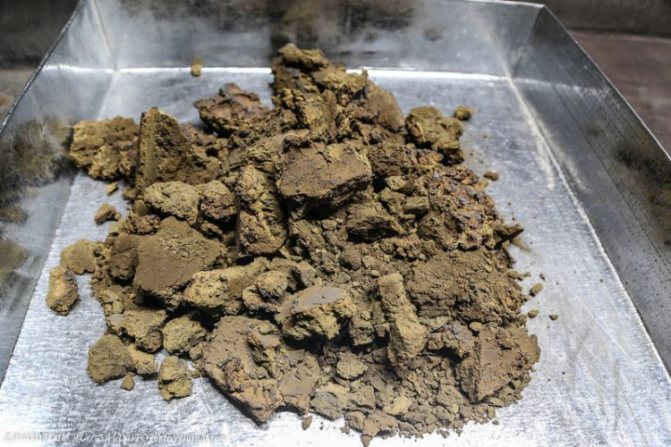
After going through all the technological processes, this is what gold looks like before smelting. This cathode deposit consists of gold (on average 80%), silver (15%) and other impurities. And from this pile you will get one 6 kg ingot.
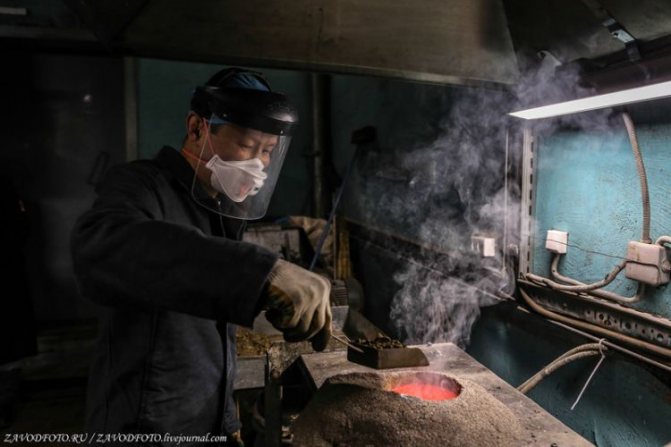
Now someone will be hot, let me remind you that the melting point of gold is 1064.18 °C.
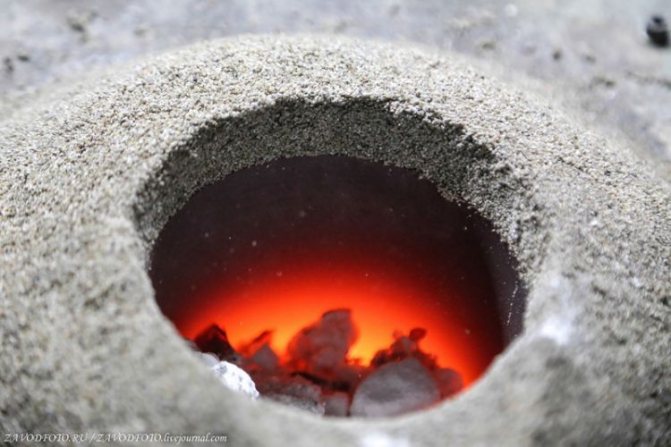
The container in which the melting takes place is called a crucible, and the melting itself lasts about 15 minutes.
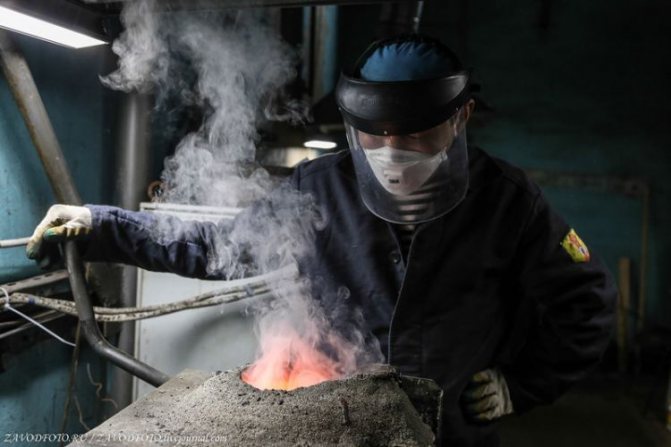
This month the guys have a target of 95 kg, and in the summer months up to 320 kg.
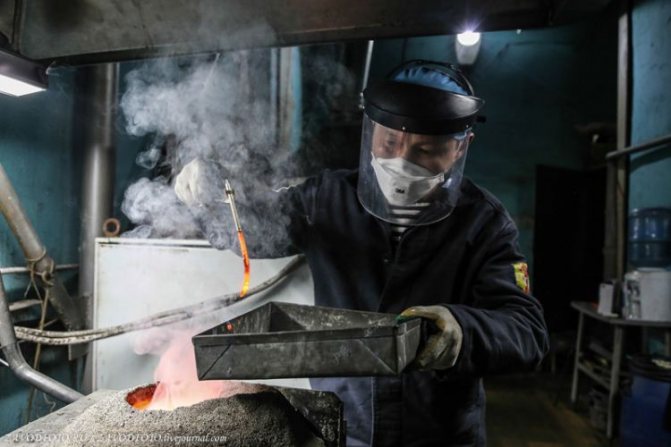
Taking a sample.
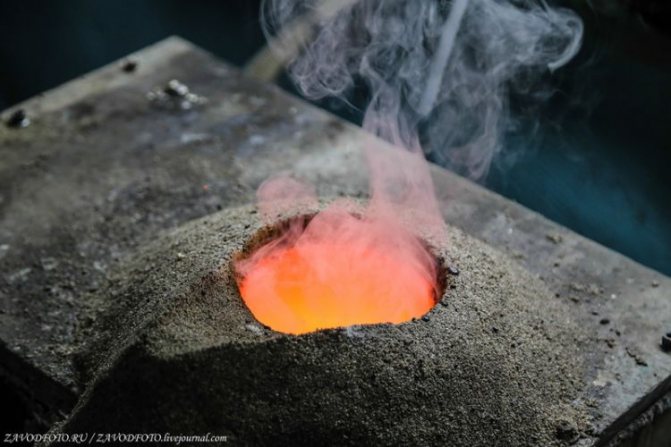
By the way, what I immediately noticed is that the color of the metal is not quite the same as what I saw from another manufacturer, here it is less yellow, due to the lack of copper.
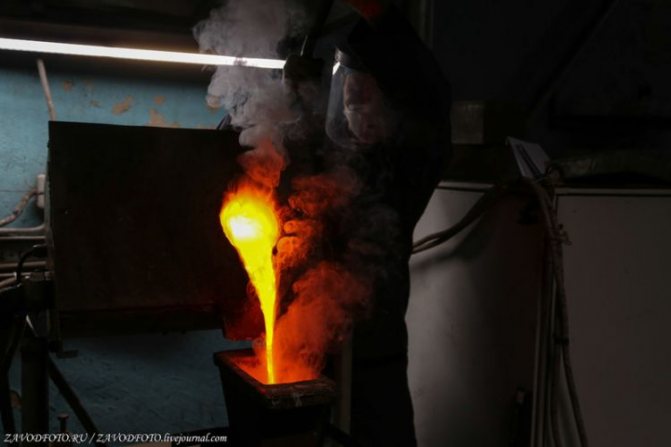
And here is the culmination of smelting, pouring gold into a mold.

The future ingot in the form of a mold
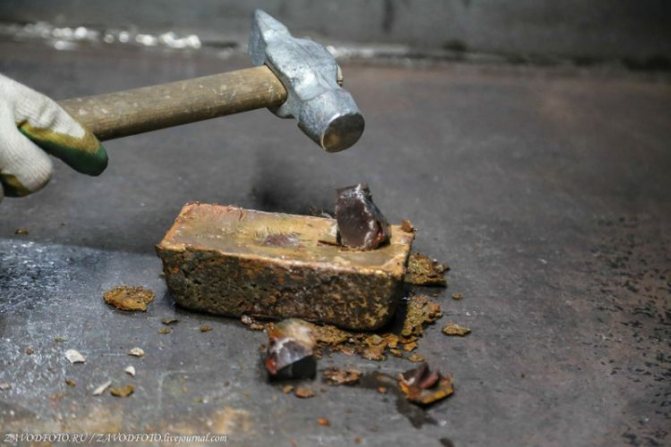
After the ingot has cooled, it is stenciled, something is tapped, something is cut off and polished.

Removing stuck slag.
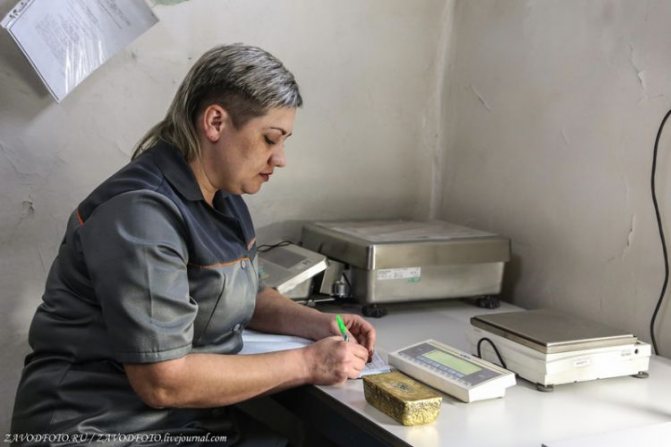
Then he goes to weight control
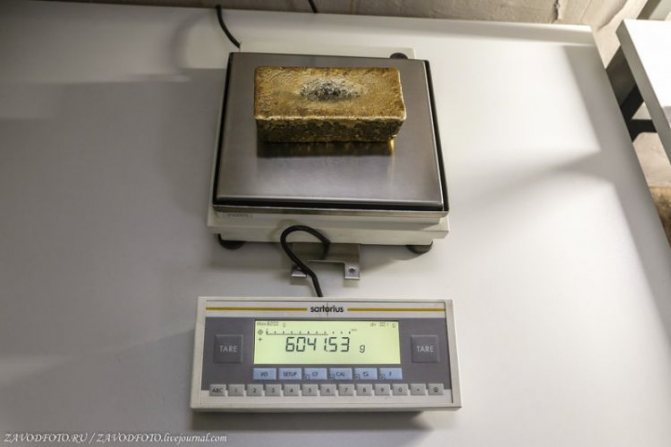
Scale accuracy 0.01 g.
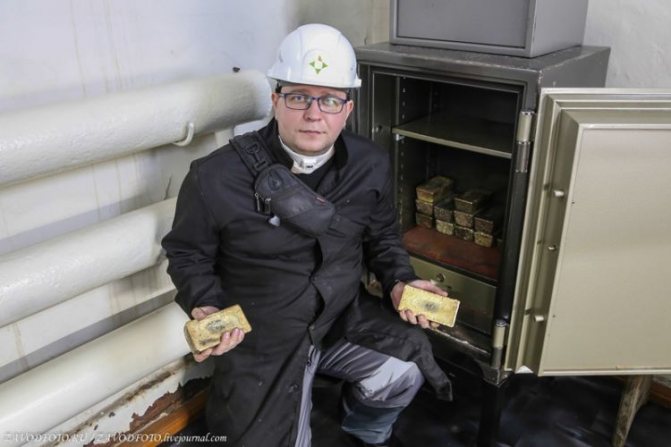
To whom? I give two pieces to one person at a time))) And this is not much, but half a million dollars
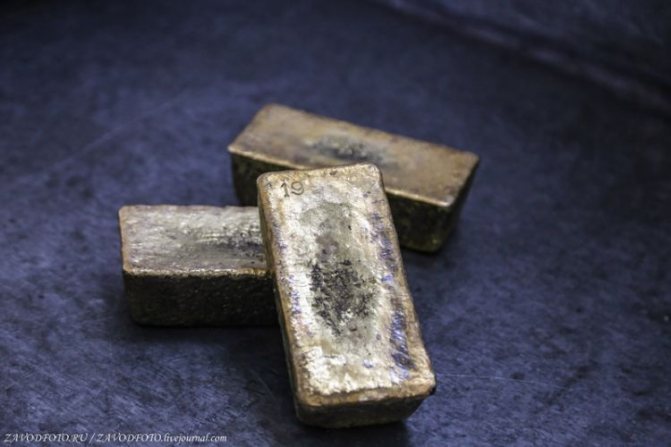
And this is the beginning of the year and there are only 19 bars, at the end of the year this figure exceeds 500
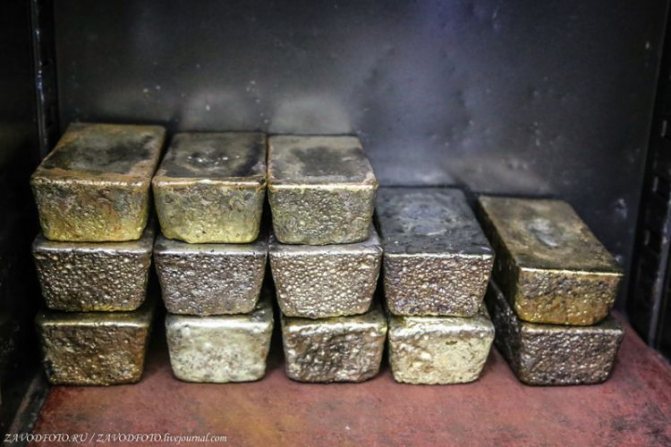
By the way, the journey of gold does not end here. Then a long journey awaits him to the refinery, and now there these bars acquire the status of four nines - 999.9.
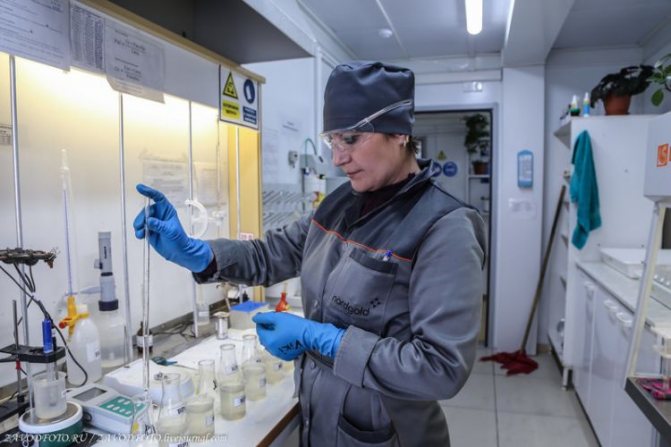
We also briefly looked into the neighboring building where the laboratory is located.
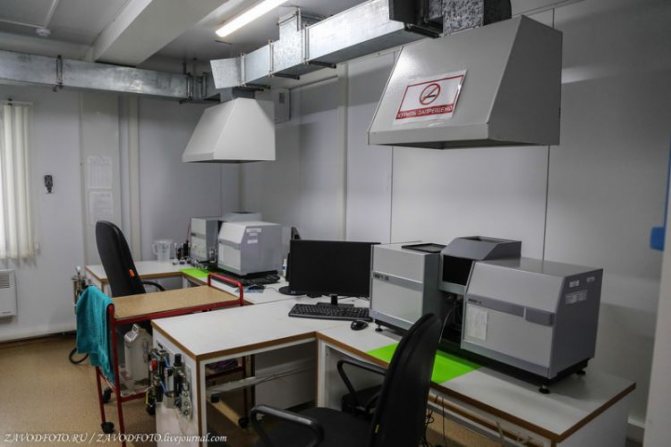
Everything here is decorous and important, it’s a pity that the girls turned out to be modest and ran away from the camera

Yeah, I see that not only bloggers are welcome here, apparently, interplanetary delegations often come here for experience...
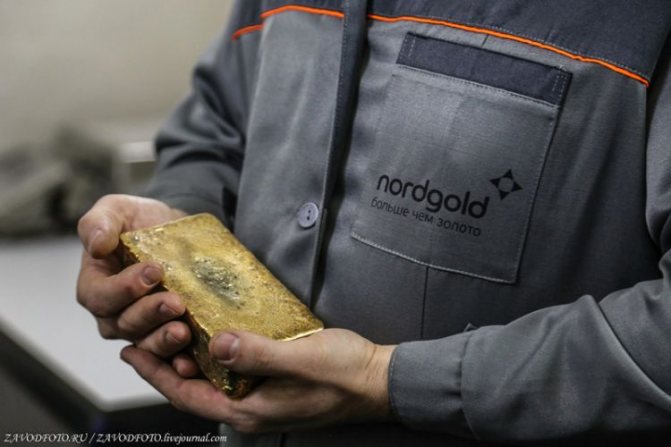
Many thanks to the entire press service of the Nordgold company for organizing such an interesting trip and personally to Ivan Tomskikh, communications specialist at Neryungri-Metallik, for on-site support!
Gold: the path from jewelry scrap to bullion
The Austrian plant Ögussa GmbH, located in Vienna, produces blanks for jewelry workshops and factories, produces laboratory equipment from precious and non-ferrous metals, and also casts measured silver and gold bars. The raw materials for bullion are scrap jewelry and outdated and defective jewelry.
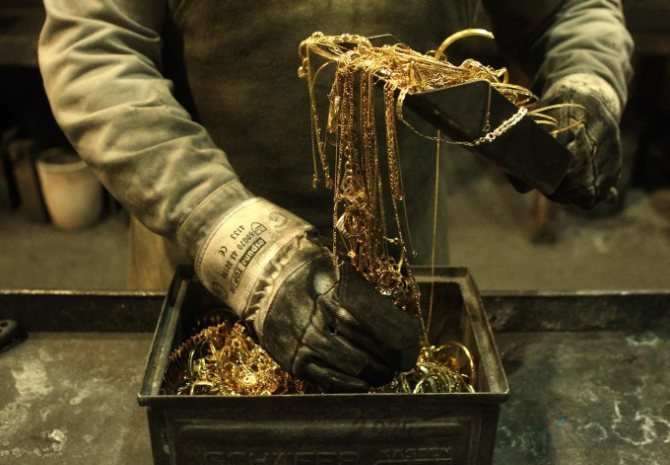
Scrap received for smelting is loaded into a smelting furnace, where high temperatures transform it into a liquid homogeneous mass, which is then cast into ingot molds. The material that goes to smelting is called “charge” or simply “charge”. The charge can be pure metals, defective ingots and jewelry, scrap and waste from jewelry production. Before entering the melting furnace, the charge material undergoes certain processing.

First, waste and scrap are subjected to cleaning treatment and only then enter the smelter.

Melting of precious metals is carried out in induction furnaces with a graphite crucible (a refractory vessel in which the metal is melted).
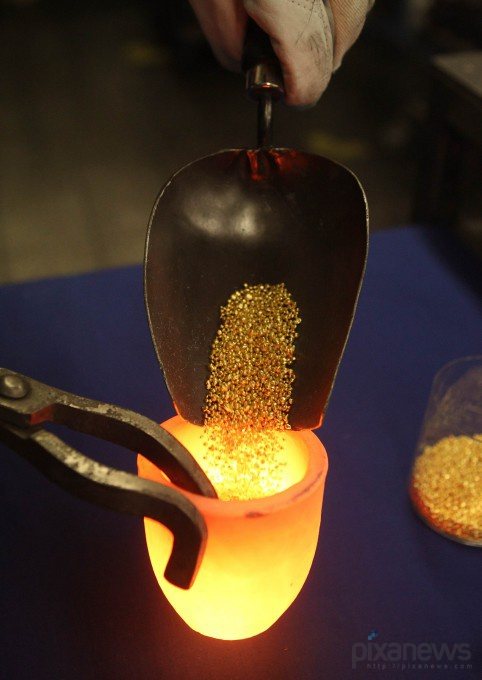
Before loading the crucible with the charge material, it is heated, then the bottom of the vessel is filled with flux. The charge is loaded into the crucible, the desired temperature is set and the melting of the metal begins. After melting the charge material, the melt is coated with a small amount of fresh flux and mixed. Maintaining the same heating temperature, the melt is left to settle. To remove unnecessary oxides and impurities, which is carried out using flux, a deoxidizing agent is introduced.

When melting a gold alloy, the furnace heats up to a temperature of 1200-1250 degrees Celsius.
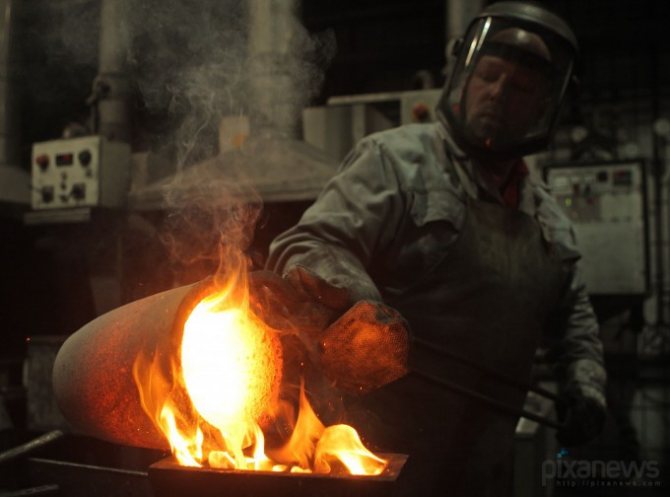
To cast ingots, molten precious metal is poured into steel and cast iron molds.
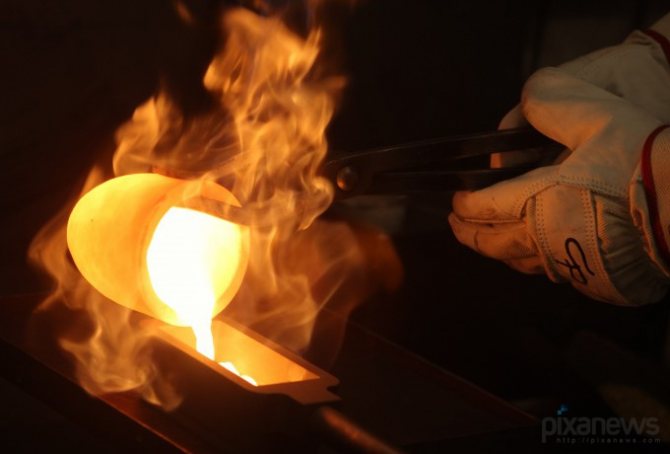
A mold (or ingus) is a mold in the form of a metal bar in which a groove is made that follows the shape of the future ingot. The molds are calcined together with technological lubricants to a temperature of 500-550 degrees Celsius. Thanks to these lubricants, the melt spreads well throughout the cell, thereby ensuring good quality of the cast ingot. The whole process is similar to making shortbread cookies in molds: the mold is heated and then lubricated with a special graphite coating so that the gold does not burn.
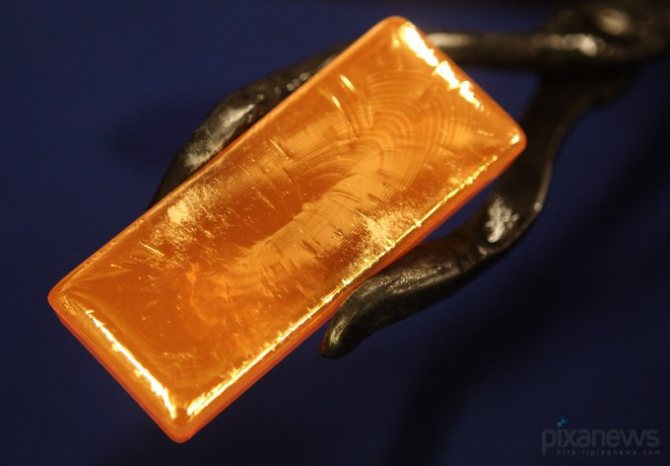
Once the melt is ready, it is cast into the mold through a special drain chute in the crucible. After completion of the crystallization and aging process, the ingot is removed.

Molten gold has a viscous, flowing consistency and looks like jelly. Gold hardens quite quickly: even when in a hot form and in a gas torch, the crystallization process takes only a few seconds. The worker then takes out the ingot and puts it in cold water.

In the chemical laboratory of the plant, a small sample of a specific melt is checked, and only after that information about it will be stamped on the ingot. If the composition of the gold is not pure enough, then it is again melted down.
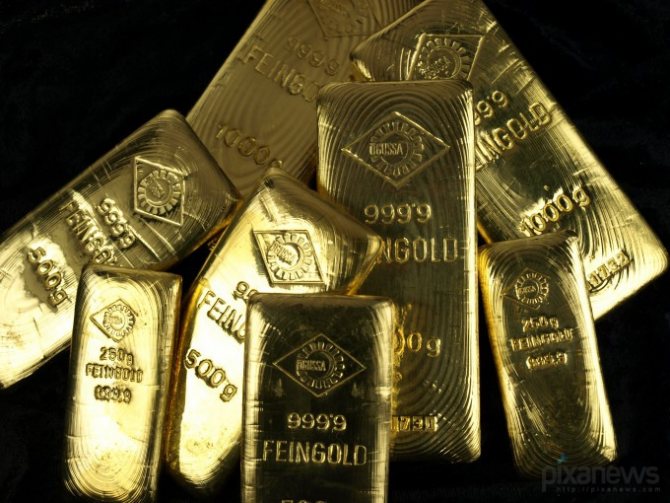
Each bar is stamped with its own number, gold manufacturer's mark and fineness.





